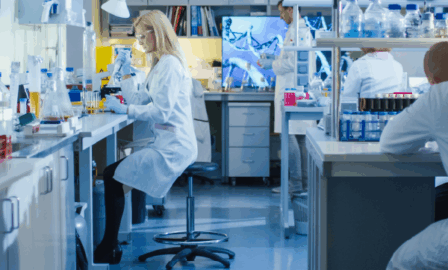What Does the Catalent Acquisition by Novo Holdings Mean for the Biopharma Industry?
Novo Holdings, the parent company to Novo Nordisk, announced a deal this morning to acquire Catalent, a leading global CDMO known for its broad end-to-end CDMO capabilities. The deal, valuing Catalent at $16.5bn, is designed to help improve supply challenges that have been holding back the growth of their blockbuster GLP-1 drug semaglutide, more well-known by brand names Ozempic and Wegovy. In the same breath, Novo Holdings announced they will sell three sites directly to Novo Nordisk, implying that the rest of the assets of the company will continue to operate as a standalone CDMO with a diversified set of customers. Below, we unpack this Catalent acquisition by Novo Holdings, discussing questions such as “what does it mean for customers?” and “does this deal reshape the CDMO market?”
How Do CDMOs Create Value within the Pharmaceutical Value Chain?
For a pharmaceutical company, purchasing a contract manufacturer rarely makes sense. On the contrary, the contract development and manufacturing organization (CDMO) market was born in response to commoditization pressures in the manufacturing process of drug products. While products have generally become more complex to manufacture, the value for the industry remains in the IP, creating the right conditions for the growth of a contract industry that can gain scale across hundreds of drug programs.
Today, most pharmaceutical companies (called sponsors in this context) utilize contractors to manufacture, or in rarer cases with the largest sponsors, supplement internal manufacturing capabilities. The span of services by several CDMOs is “full suite,” allowing even small virtual sponsors to develop and optimize their products and manufacture via a partner. Catalent has in many ways led this charge and established itself as an organization offering the highest quality, the largest scale, and broadest capability set.
So why would a Novo Nordisk move against this trend to vertically integrate and own manufacturing capacity rather than outsource those activities to the CDMO industry like their peers?
Examining the Catalent Acquisition by Novo Holdings
Novo is in a Unique Position to Make this Deal Happen
Novo Nordisk is in a unique position to create significant access and value with this deal. While there are nuances to the corporate structure that controls Novo Nordisk (and manages the deployment of their retained earnings), for the sake of argument we will treat the entities as the same.
First, Novo Nordisk has earned a highly desirable and unusual position within the market where they have virtually unconstrained demand for their product. The volume of demand and expected future demand for their product is quite literally off the chart for the industry, and Novo’s sole focus on the diabetes and obesity markets gives them the ability to concentrate resources and plan for the long term compared to more diversified peers.
Much credit should be given to Novo Nordisk, who pioneered the development of the GLP-1 class along with Lilly and launched semaglutide with unique clinical and commercial differentiation. Both products have gone on to gain tremendous brand recognition because of the outcomes the products create.
Unlike many products with outcomes that are only apparent to the patient and healthcare provider (HCP), significant weight reduction has caused a frenzy to learn more about the product. High profile media, along with the grassroots conversations when you see someone you know that’s lost 15% of their weight, have combined to create unforeseen buzz around this product that ultimately translates into more inquiries in the HCP’s office and greater patients on treatment.
While Ozempic is approved for the management of diabetes, their follow-on product Wegovy addresses the underserved obesity market. The obesity market has not had step-change product innovation over the life of the market, which has caused peer pharmaceutical companies to pass on development in the space in lieu of other categories with greater and shorter-term return potential. This has left Novo in a situation with limited competition and tremendous demand.
Novo Nordisk’s management has been loud and clear that demand is so great that they will remain supply-constrained into the future as they chip away at the opportunity cost and expand supply. The Catalent purchase certainly helps move the needle, but it’s not yet clear how fast this accelerates the path to supply-demand balance of that market opportunity.
Uniquely Bullish on the Future of the GLP-1 Class
Importantly, the demand profile for GLP-1 drugs, and for Ozempic and Wegovy in particular, isn’t expected to slow down any time soon. Lilly offers a competitive set of products. including Zepbound, approved for obesity. While more competition has drugs in development, Novo Nordisk also has its own next-generation products in the pipeline currently under development.
Consider for a moment the long-term implications of a drug that sustainably helps to manage obesity. The growth of instances of obesity in the U.S. alone is staggering, with more than 40% of U.S. adults qualifying as obese, up from 26% in 2008. The U.S. isn’t alone in this trend, as research estimates that more than four billion people – half the world’s population – will be obese by 2035. This isn’t to make mention of the important connection between obesity and several comorbidities that require pricy health interventions and opportunity cost to society at the macro scale.
A drug that can help this equation in a sustainable way with a decade-plus of patent life remaining may be game-changing for nations. While most private insurers in the U.S. are focused on short-term health outcomes, government payers are optimizing for life-extending outcomes and are the ultimate beneficiaries of these products and therefore incented to create access to them. By providing a sustainable supply, Novo is also signaling its long-term ability to execute and deliver on the potential for this market.
There are also competitive implications of this deal by Novo Nordisk that challenge its main competitor Lilly. This effectively prevents Lily from utilizing Catalent’s capacity to expand its own supply and also gives Novo a greater foothold in the U.S. Novo Nordisk had previously announced more than $6bn in manufacturing investments to help drive supply, and this deal only accelerates the manufacturing economies the company is creating.
Focus, Resource Allocation, and Timing Enable the Deal Structure
Beyond Novo’s corporate structure, where non-profit board Novo Holdings retains control of Novo Nordisk and its profit allocation, there are several additional structural elements to Novo Nordisk, Catalent, and the deal structure that make it an ideal strategic fit today.
First, Novo Nordisk is unique at its scale in its portfolio focus. Both Novo and Nordisk that merged in 1989 to form Novo Nordisk have always been focused solely on the diabetes market. In the rare case where they explored another new market, they ended up exiting the business via a spinout (see Novozymes in the enzymes market). Even today, the joint entity only focuses on two markets: diabetes and obesity.
This, supported by its ownership structure (a private, majority vote holding entity), enables a very long-term view. While other publicly traded companies have followed the market trend of diversification to create new revenue streams, manage concentration risk, and satisfy investors, this sole focus allows Novo to make decisions through the lens of what is best for this specific patient set and market potential. Their current position as category captain with the largest share in the space also means that every unit of growth for the market disproportionately benefits Novo Nordisk.
Combine this with Novo Holding’s large cash pile and assets under management in excess of $100bn, and the company has found itself without the financing challenges that come along with other large asset acquisitions. As a part of this deal, Novo Holdings has also carved out and sold through three of Catalent’s sites directly to Novo Nordisk’s operating entity, meaning those sites will become fully focused on supply for Ozempic, Wegovy, and future Novo products alone.
The timing of the deal is also ideal for Novo. In August of 2023, Catalent announced it had entered into a strategic review prompted by a primary investor, Elliott Investment Management. This means that the board has been seeking value creation opportunities for their shareholders, whetting the appetite for deal making. This review had only been underway for six months, also marking a major victory for Elliott.
What Does it Mean for Customers?
Clearly, this deal creates benefits and has strategic fit for Novo Holdings and Novo Nordisk, but what about the hundreds of sponsor customers of Catalent that preceded this deal?
Sponsors that are developing or manufacturing products competitive to Novo Nordisk’s with Catalent are forced to immediately consider shifting manufacturing focus. While Catalent will continue to offer their suite of services to the market, those in a competitive position will be forced to spend additional resource, planning, and, importantly, time to determine how to address the elephant in the room. This could slow development cycles and requires unplanned investments to assuage doubts prompted by the deal.
For those in adjacent markets, the deal is the most interesting. On one hand, the organization is now owned by a specific competitor in the space, which creates greater risk and reliance on a competitor. Those companies are now effectively subsidizing development for Novo Nordisk with their CDMO service fees. On the other hand, it may improve the attractiveness of Catalent’s services assuming, that they gain investment from Novo Holdings to improve their services and assets available to sponsors.
For sponsors of non-related products that utilize the three sites transferred to Novo Nordisk, they’re now in a scramble to understand what components of the process need to find a new home and which home that should be. The overall drug manufacturing market, particularly for more complex biologics products, is already constrained as is. Sponsors will seek to execute a transition without interruption to supply.
Finally, those that utilize Catalent for its broad range of services, but aren’t directly impacted either by a product in the same category or the sites transferred directly to Novo Nordisk, will likely conduct a strategic review to affirm that it’s in the best interest of their patients and their organization to continue using those services. However, it doesn’t mean that Catalent will see negative demand shifts. As mentioned, for many, this may improve the attractiveness of their services due to greater investments by a new, deep-pocketed parent, and for others may signal a need to change or have alternate options available.
Does this Deal Reshape the CDMO Market?
While this deal is of significance for the market, it’s not likely that other companies will follow suit to purchase their own CDMOs because of the unique conditions Novo Nordisk enjoys. No other products in the market currently enjoys the extent of competitive advantage that Novo does, making a deal less attractive to other companies without that element to the flywheel.
It will, however, accelerate a growing shift in thinking by sponsor organizations around risk management and partnership agility. This trend was catalyzed by the pandemic, when pharmaceutical supply chains were significantly challenged to maintain supply. The response has been to either diversify the contractors that provide CDMO services to hedge risk or to create greater readiness and flexibility in the case that the need arises to shift between CDMOs.
This deal makes that flexibility and agility requirement even more important for sponsors and has implications for every facet of how a biopharma company plans development and manufacturing. Sponsors will continue to build their processes, technologies, and data structures to move between contract partners more easily as needed.
Integration of development, quality, and supply chain data and systems has been a focus of investments that will continue between sponsors and CDMOs with this news emphasis around flexibility. Likewise, it elevates the importance of the program management skillsets in organizations that facilitate connections between sponsor and CDMOs.
Catalent is also the largest gene therapy CDMO in the world and one of the only with commercial experience in the categories with the most complex products to make. This leaves many open questions for those sponsors about existing clinical partnerships, timelines, staffing, and overall focus on their market.
Lastly, the deal also renews the conversation on the macro level for the importance of CDMOs as a strategic asset for the self-reliance and national security of the pharmaceutical supply chain. Even since COVID, CDMOs like Resilience and Phlow have gained tremendous scale positioned to provide greater assurance of supply of all drugs amidst global conflict and an environment of deglobalization.
To chat more about the Catalent acquisition by Novo Holdings, contact us today. You can also learn more about our contract manufacturing consulting services here.




